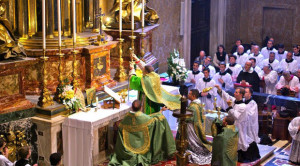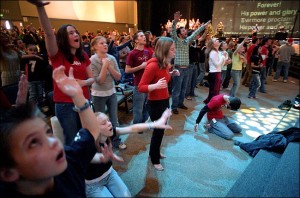[P]eople at different historic periods are more or less sensitive to signs as such. Some people are deaf or blind to non-verbal signals.–Mary Douglas
I’m back after a long layoff owing to travels and recuperation after our major building project this summer. And I have been promising for some time to write some things about Mary Douglas. I’ve begun here with one of many important quotes from what I consider to be her most important book, Natural Symbols. This book is not as famous as her breakthrough (and perennial classic) Purity and Danger. If you are looking to read her work, I’d start either with Purity and Danger or with one of her excellent Biblical commentaries, probably Leviticus as Literature.
But let’s look at this quote. She is saying that human sensitivity to “signs” depends on one’s historical situation. This quotation appears early in Natural Symbols, a book she wrote in response to the widespread rejection of ritual and symbol in the late 1960’s. She was also writing as a concerned Catholic, for whom ritual was a a life-affirming part of her experience. Finally, she wrote as an anthropologist, who had the opportunity to witness the use of ritual in other cultures, and to reflect on the purpose and effect of ritual in building social ties and shared meaning. Natural Symbols is a book that attempts to demonstrate the connection between three levels of experience (listed here from most to least general and abstract): 1) our system of belief about the world, society, God, and evil; 2) the way in which belief is communicated by and shapes society and the control it exercises (or fails to exercise) over us; 3) our experience of being a body, and the ways in which we use our bodies to communicate our shared (or unique) beliefs about the world and our place in it.

Super-dense symbols at Latin high Mass. Note the strict bodily postures of the participants, their orientation, etc.
Let me unpack that last sentence with a concrete example. This will help to explain why I consider the book so important for understanding the malaise afflicting religious life in particular, and the Church in general. In a Catholic monastery, we say that we believe in the Mystery of the Incarnation. This implies that Christ is incarnate in the men with whom we live, and therefore regulate the ways in which brothers relate to one another. As the Prior, I am understood to hold the place of Christ (properly speaking) in the community. This means that brothers don’t refer to me as “Pete,” or sit in my place at table, in choir, or in chapter. Brothers act out, in their own bodies, symbols of the Incarnation. Thus we all genuflect when we enter the church, recognizing Christ’s Real Presence in the tabernacle. We bow to one another to acknowledge Christ in each brother. We discipline our bodies in accord with the social demands that communicate a system of belief.
But what if we happen to enter the monastery as part of an unlucky group that is “less sensitive” or even “deaf or blind,” to symbolic expressions like places of honor, genuflections, pectoral crosses, bows….even habits, tonsures, icons, candles, holy water, etc? I could go on and on. The point is that monastic life as such is as life that is based upon a belief system that is strongly tied to an intricately detailed set of symbolic observances. What if we enter such a life lacking the faculty to see and interpret the symbols?

A less ritually rigorous approach to worship. Note the varying postures, vesture (wink), and lack of identifiable architectural context.
After many years in monastic life, I have some to the conviction that most young men and women entering religious life today do so without the ability to understand the meaning of the symbols of the traditional life. Furthermore, I think that it is quite possible to engage in these symbolic behaviors without ever really grasping what they mean.
What makes me think this? Before Vatican II, the Church in general was governed by massive amounts of rule-bound behaviors that were intended to communicate a certain theology. Strong social disciplines regulated what bishops, priests, religious, and laity could and could not do. When the reforms of the Council began to take hold, huge percentages of Western Catholics quickly gave up all kinds of symbolic behaviors and social disciplines without any apparent grief (for others, obviously, these changes were devastating; Mary Douglas is very sensitive to their suffering, and in some ways this book is an anthropologist’s effort to help redress the wrongs that were just unfolding in 1970 when Natural Symbols was published). This suggests that there were large portions of the Catholic Church for whom, in 1960, the symbols and disciplines already were more or less meaningless, that their importance had been forgotten, despite the fact that everyone continued to engage in them.
In my experience, young men entering a traditional monastic life such as our is reputed to be are looking for the structure that ritual and discipline provide. But I have also observed that for many of these same men, the real meaning of these rituals can be easily misunderstood. I will attempt to explain what I think is actually going on in a later post. Here, since I must wrap up, let me just point out that an effort to put her ideas into effect in our monastery has had surprising consequences (good ones, so far). And Professor Douglas’s concerns turn out to have a lot in common with the diagnoses of Alasdair MacIntyre, Rene Girard, Fr. Henri de Lubac, George Steiner, Pope Benedict XVI, and others writing from a variety of disciplinary backgrounds. Those who are interested in the so-called “Benedict Option” would do well to pay close attention to Mary Douglas, if they really wish to avoid becoming sectarian pariahs. More than that, Douglas helps to explain why MacIntyre and de Lubac seem to be often misunderstood even by their own strongest supporters. Changing my belief requires me to change my social experience and to change the way I use and experience my body. Without social structure and asceticism (the disciplining of the body), philosophical and theological ideas will, in our world, tend to float free and remain largely inconsequential beyond the tempest-in-teapot-blog-combox skirmishes. I hope to show why this is the case in the coming weeks.